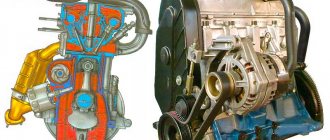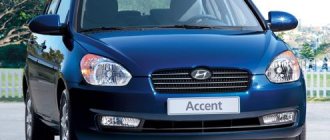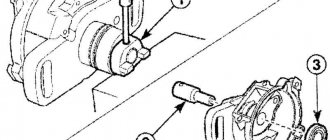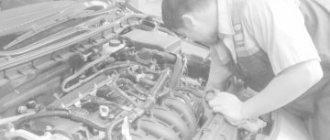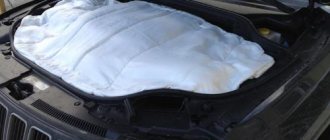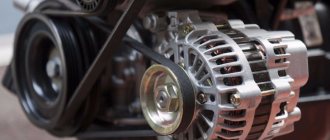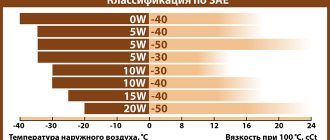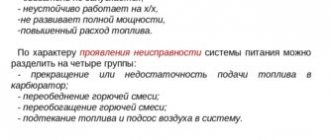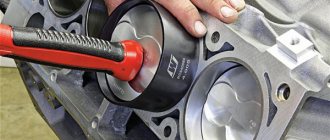One motor for two volumes
I’ll say right away that when choosing a Kia Rio 3, you don’t have to worry too much about choosing an engine. The difference in the acceleration dynamics of 1.4 and 1.6 is minimal, and the technical differences between these two engines are so insignificant that it is simply impossible to identify the unit externally. You can’t see the crankshaft and connecting rods indiscriminately, not everyone can decipher the engine model on the sticker, which, in fact, is what many scammers use, selling 1.4 under the guise of 1.6, in the hope that the buyer simply will not look at the required column in the PTS. And it's very easy not to notice.
Externally, 1.4 and 1.6 are absolutely identical
The service life of both engines is also practically the same. Even though the manufacturer stated a maximum mileage of 180 tkm, in practice the piston engines of both engines cover at least 230 tkm, and with a responsible approach to maintenance, even 300 thousand km. In short, Rio loves good 95 gasoline and oil changes every 10 tkm.
Kia Rio engines are chain driven, but this does not mean that you won’t have to interfere with the timing
Before the onset of their last days, the units may require not very expensive, but still attention from you. For example, by 100 thousand you may need an unscheduled, I would even say unexpected, replacement of a stretched chain and a completely routine adjustment of valve clearances. The catalytic converter (catalyst) also crumbles considerably by this point and the risk of crumbs being drawn into the combustion chamber increases, which has caused premature piston wear for a number of owners. At the first signs of loss of traction and an error in the efficiency of the “catalyst” appears, you will have to worry about removing it and reflashing the ECU, or expensively replacing the converter, otherwise you can spend even more money.
The crumbled “catalyst”
Kia Rio 3 engines are not very picky about the climate, but the units are sensitive to cold weather when the needle drops to the -20 mark - they do not always start, especially with a standard battery. One way or another, you can warm up the car and there is no risk of breakdown, which cannot be said about the tendency of Rio engines to overheat. Here in the Urals this rarely happens, but in areas to the south they complain that if you don’t flush the radiator every season, the risk of “frying” the engine increases many times over. The cooling system is already designed end-to-end, but there is also dirt, bent radiator honeycombs and insects that interfere with heat transfer and reduce reliability.
Flushing the radiator once a year is more a necessity
Oil leaks rarely bother Rio units - sometimes only the front crankshaft oil seal and the valve cover leak.
Features of the 1.4-liter Kia Rio engine
To begin with, we note that this power unit is basic. Its special feature is the ability to 6300
rpm to develop engine power considered equivalent to
107
horsepower.
Taking into account the use of AI-92, this is a very good indicator. The manual transmission allows the car to reach a speed of 100 km/h in just 11.5
seconds.
On the open highway, such an engine consumes only 4.9
l fuel.
Driving on city streets increases gasoline absorption to 7.6
liters.
Combined cycle travel is characterized by a fuel consumption of 5.9
liters.
In another measurement system, 1.4 l corresponds to a volume of 1396 cm3. The engine has four active cylinders
.
Each of them has 4 valves. The piston stroke is determined by 75 mm
inside a cylinder with a diameter of 77 mm.
Fully using the resource of the Kia Rio engine, the driver is able to reach speeds of up to 190 km/h. Such indicators are very acceptable for domestic motorists who prefer fast driving with minimal fuel costs.
Take the automatic
Candidates looking for a used Kia Rio 3 should not stress themselves too much with the choice of gearbox. If you want an automatic, take it - you won’t regret it. There are almost no problems with “hydromechanics” if you change the oil periodically, but when buying a used Rio, it is better to check the manual transmission thoroughly, shifting all gears during a test drive. The weak point of the transmission is the third speed synchronizer. If you hear a “crunch” when you turn it on, then look for another car or ask for an appropriate discount on the gearbox capital.
Up to 150 tkm there are almost no problems with the clutch if you use it properly. Some even drive 200 thousand with the original clutch, largely thanks to the delay valve for smooth engagement, which helps the driver not to “burn” the basket and kill the gearbox prematurely.
Advantages of the 1.6 l power unit
Most modern car enthusiasts prefer to purchase cars with just such an engine. When choosing, take into account the following positive aspects that characterize the motor:
- savings
due to reduced fuel consumption. Moderate driving on a combined cycle highway requires only 6 liters of fuel. Personally, I always poured gasoline precisely from this calculation; - attractive
is the extreme reliability of the main functional components, ensuring trouble-free operation of the Kio Rio sedan engine for more than 200 thousand kilometers; - high dynamism
, characterized by the ability to accelerate to 100 km/h in just 10.3 seconds; - The optimal distribution of characteristics between the engine and transmission creates excellent elasticity of the power plant
. This gives the driver confidence in the most difficult driving situations.
Despite some difficulties caused by the impossibility of partially replacing certain elements of the gas distribution mechanism and ignition system, repairing the Kia Rio engine is quite common
. The cost of such services is also considered quite acceptable.
The exceptional resource life of the power unit is confirmed by car owners who have covered more than 300 thousand km
. A remarkable fact is that the sedan did not exhibit any noticeable problems with the engine.
The manufacturer provides for the need for a technical inspection after every 10 thousand km.
Even middle-income car owners can easily afford to use the services of specialized workshops. The affordable cost of maintenance is explained by the simplicity of the power unit design.
There are several secrets that can increase engine life:
- The trouble-free service life of a car largely depends on what kind of oil is poured into
the Kia Rio engine.
It is recommended to choose brands from trusted
manufacturers, taking into account the seasonality of the petroleum product.
You should also regularly update the engine oil for the Kia Rio, making sure to replace the oil filter. Manufacturers have established a maximum mileage of 15,000 km using the same lubricant. However, experienced drivers try to change the oil product every 7000 km
; - Gasoline should be filled exclusively at specialized
gas stations. This will help eliminate the use of low-quality fuel. Cheap counterfeit fuel can quickly damage a perfectly serviceable power unit; - The last tip concerns driving style. A calm, measured drive
will preserve the car much longer than reckless driving.
Watch an interesting video on this topic:
Many car enthusiasts have long noticed that in order not to make a mistake in choosing a car, they should give preference to a car that is popular among the masses. For several years now, the Hyundai Solaris has been considered the leader in the sedan class. Against the background of such success, the twin of this model, Kia Rio, looks a little sluggish. However, this is only when compared with the absolute market leader. At the same time, Rio is selling much more successfully than other models in the same class, including Logans, Polos and Rapids.
Attention! In just the four years that this Korean car was sold in Russia, approximately 400 thousand cars were sold. No supermini class model can even come close to repeating such a result.
Kia engineers studied all the mistakes that were made by Hyundai manufacturers, such as suspension settings, ABS, trunk lid, etc. But most importantly, the creators of Rio immediately managed to stir up the public’s interest.
But, nevertheless, if you believe the reviews of the owners, the Kia Rio still has shortcomings. Therefore, in order to understand all the pros and cons of the Kia Rio, you need to study the reviews as carefully as possible.
Too soft
The resource life of the Kia Rio chassis does not raise any questions – behavioral features are more worrying. There were so many complaints from angry owners who almost lost control on the highway because the rear shock absorbers were too “soft,” allowing the rear to sway from side to side, causing loss of control. They live long enough - there are no questions about that. But the desire to change them to more “hard” non-original ones arises almost immediately after purchasing a car, which is what Rio/Solaris owners do.
Let's return to the reliability of the chassis. The weak point in the suspension, perhaps, is the front wheel bearings - they begin to “play” after 30-40 tkm. Just don't rush to replace them. It is quite possible that you can get by with tightening the fastening nut and drive at least the same distance.
Stabilizer bushings are in second place - their service life is approximately 100 tkm. The silent blocks of the front levers on the third one are 130-150 tkm, while the ball ones are practically indestructible - they calmly hold on even at 250 tkm. The front shock absorbers work fully on average for the first 100 thousand km. Nothing ever happens to the rear beam, which was initially clear when getting acquainted with the design, if such a simple device can be called that. Breakdowns are excluded here.
The steering, unfortunately, cannot be praised at all - it’s finicky. Even if we ignore the cases of early leaks of power steering pumps, which were fixed under warranty, then there is still something to complain about. For example, the steering rack. It seems as if the manufacturers have colluded and are purchasing the steering unit from one supplier, who in turn equips the mechanism with low-quality guide bushings. In the case of Rio, knocking can be heard after 40 tkm. The only thing that pleases is the maintainability, which is inherent in all the mechanisms of the model. So the rack can be made noiseless relatively inexpensively, the main thing is to find a good specialized service.
The steering shaft cross sometimes causes a “stiff steering”
Despite the rather productive power steering system, one day the Rio 3 may confuse the owner with a “stiff steering”. There is no need to worry too much about this, because the weak point can be eliminated simply and trivially - by lubricating the “universal shaft” of the steering shaft. The most important thing is not to delay solving the problem, otherwise, after the loss of the amplification effect, knocks from the worn cross will appear, which is why the latter will only have to be replaced.
Wet power steering pump
Steering tips safely survive up to 100,000 km, and then it will depend on the accuracy of the driver and the operating conditions of the car.
Characteristics of the Kia Rio power plant
Korean manufacturers have taken care of the convenience of Russian motorists. Their creation is perfect for domestic roads
. This is facilitated by the following characteristics of the power unit:
- possibility of refueling with AI-92 gasoline. For most owners of a budget vehicle, the issue of saving comes first, so using cheap
fuel is important; - anti-corrosion compound
is very useful , protecting the underbody from the effects of domestic dirt; - harsh climate is not an obstacle to starting the engine.
to start the engine at temperatures down to −35 C. Therefore, the car has proven itself well even in the northern regions; - Domestic utility workers fight icy winter roads by generously sprinkling them with salt. Korean manufacturers have secured the radiator
by protecting it with a special composition that protects it from such troubles.
It should be noted that the Kia Rio provides for the installation of power units of two
types differing in volume and power. Each of them requires separate consideration.
Kia Rio 3 competitors
The main competitor of the Kia Rio 3 is its technical twin brother, the Hyundai Solaris - the weak points and breakdowns are absolutely the same. Renault Logan has also been on this market for a long time and, despite the lost positions, is not going to give up. The “French” will be at least no worse in reliability, showing off to applicants for a used car even archaic, but more durable units. The Volkswagen Polo Sedan with its “knocking” engine has not disappeared from the market either. For people with family values, the Skoda Rapid liftback is more suitable. The main thing is to choose the right motor.
Author: Denis Putkov,
Kia Rio 3 – VIN location and engine number
Engine
The engine is produced in China at a plant owned by the Korean concern Hyundai/Kia. Therefore, all quality standards are met. The peculiarity of the engine is that it does not have hydraulic compensators, and therefore needs to adjust the valve clearances. And this is his biggest drawback. According to the regulations, adjustment should be carried out after 90,000 km. This work is quite complicated, as it involves dismantling the camshafts. And by the 200,000 km mark, the chain will need to be replaced. The procedure is also quite labor-intensive.
In addition, in the immediate vicinity of the engine there is a unit that, in a bad situation, can kill the engine - this is the catalytic converter. If material from broken ceramic honeycombs gets into the cylinders, damage to the piston group and scuffing on the cylinder walls are inevitable. And this leads to a major overhaul of the engine.
Filling fuel at branded gas stations can prevent the problem. The beginning of destruction of the ceramic block is observed no later than 80,000 km. To play it safe, you need to inspect the ceramic surface through the hole for the oxygen sensor and, if necessary, replace the neutralizer with a repair one.
The cooling system reserves of the motors are small, so overheating is possible with clogged radiator honeycombs. The same consequences were caused by a curious malfunction with the weakening of the fastening of the electric fan impeller to the shaft. The problem was aggravated by the fact that some machines of the family did not have a dial temperature indicator in the simple configuration. And when the red symbol lights up in the instrument cluster, it may be too late.
Nevertheless, this engine can be considered relatively reliable if the oil change intervals and regular diagnostics are observed (or better yet, reduced).
The most common problems and types of repairs
Below is a description of breakdowns typical for Rio and the main methods for repairing them.
Transmission
The main signs of a malfunctioning gearbox are as follows:
- slipping when switching between gears; strange vibration at speed; jerking when accelerating; the required gear cannot be engaged.
If the listed symptoms are noticed, then it is necessary to repair the gearbox as quickly as possible. It should be borne in mind that repairing a gearbox is a very complex undertaking that requires a lot of time. The specifics of gearbox repair require that it be carried out by a team of at least two workers.
Cooling radiator
A common disease of KIA RIO is rapid contamination of the radiator. The main signs of a radiator leaving its normal state are: – antifreeze leak; – rapid engine overheating; – slow engine cooling. When repairing a radiator after dismantling it, it is necessary to identify damaged areas. To do this, place the radiator in water and watch for air bubbles rising from the leakage points. If the radiator has cracks or holes, it must be replaced with a new one. However, if you have certain skills, you can try to repair a damaged radiator yourself. To do this, you can try soldering weak points, using a special paste (cold welding), or pouring stop reagents into the radiator. In the best case, you can drive a repaired radiator for several years, but for the most part it starts leaking again very quickly and at inconvenient times. Therefore, the best way to repair a radiator is to replace it with a new one.
Fuel system
The main sign of a fuel system malfunction is gasoline leaking from the fuel tank. The main reasons for the appearance of a puddle of gasoline is damage to the gas tank or filler pipe. You cannot drive a car with such defects. A damaged fuel tank or filler pipe must be replaced immediately.
Electrical wiring and electrical equipment
As in most cars, the operating voltage of the negative grounding of the electrical equipment system of a KIA RIO car is 12 volts. Such voltage is not very dangerous to life, but in the event of a short circuit it can lead to failure of many electrical appliances and even to fire. Operating electrical equipment in Russian conditions can cause quite a lot of unpleasant moments. In this regard, it is necessary to regularly check the stability of the insulation and fastening of electrical wires. You need to make sure that the wires do not fray or touch each other.
The electrical system of the KIA RIO car is reliably protected from overloads by special fuses. They are located in two panels, one of which is located near the driver's seat, and the other in the engine compartment. When lights, bulbs, sensors and any other equipment fail, it is often enough to find the appropriate fuse and replace it with a new one. To carry out such a replacement, you do not need to contact the service station.
The main thing is not to confuse standard fuses with main fuses for high current.
Body problems
Corrosion of the KIA RIO body occurs quite often in our climate. Like any other car, the body of a KIA RIO may experience various scratches, chips, dents, violation of the geometry of body parts, and the like. In fact, many car enthusiasts can handle poor body repairs. But high-quality repairs, in which the geometry and surface of damaged body parts are completely restored to factory condition, can only be performed by experienced craftsmen using modern high-tech equipment.
In general, KIA RIO has an excellent paint coating, as well as excellent anti-corrosion treatment. A relatively weak point here is the sometimes observed accumulation of moisture in the trunk and, in connection with this, the development of local corrosion. Therefore, first of all, it is necessary to carefully monitor such weak nodes and in a timely manner. BUT still, the main problem of the KIA RIO, like any other car, is the occurrence of mechanical damage associated with accidents or bad roads. To eliminate body damage, local or complex repairs are used. During local repairs, the original shape of the body is restored without replacing it with a new part. During a comprehensive repair, a part or parts of the body are removed and replaced with new ones. Also, body repair almost always includes paintwork, which is carried out using special paint sprayers in drying chambers.
All types of KIA RIO car repairs are best carried out in specialized technical centers of Kia dealers.
